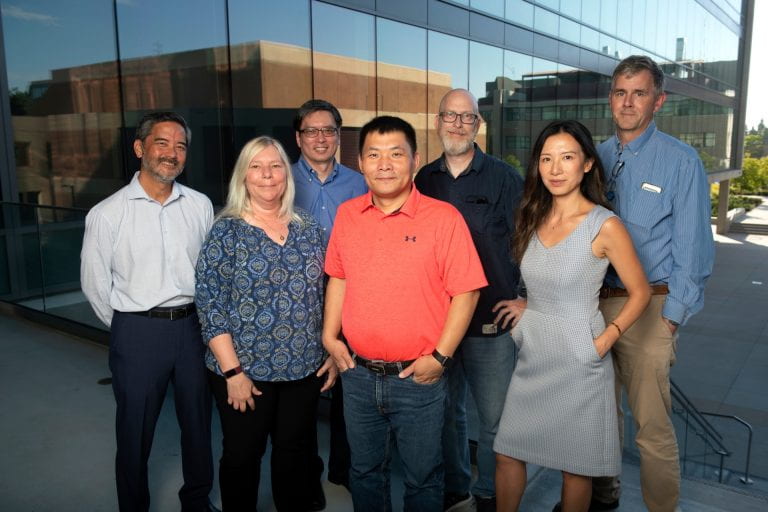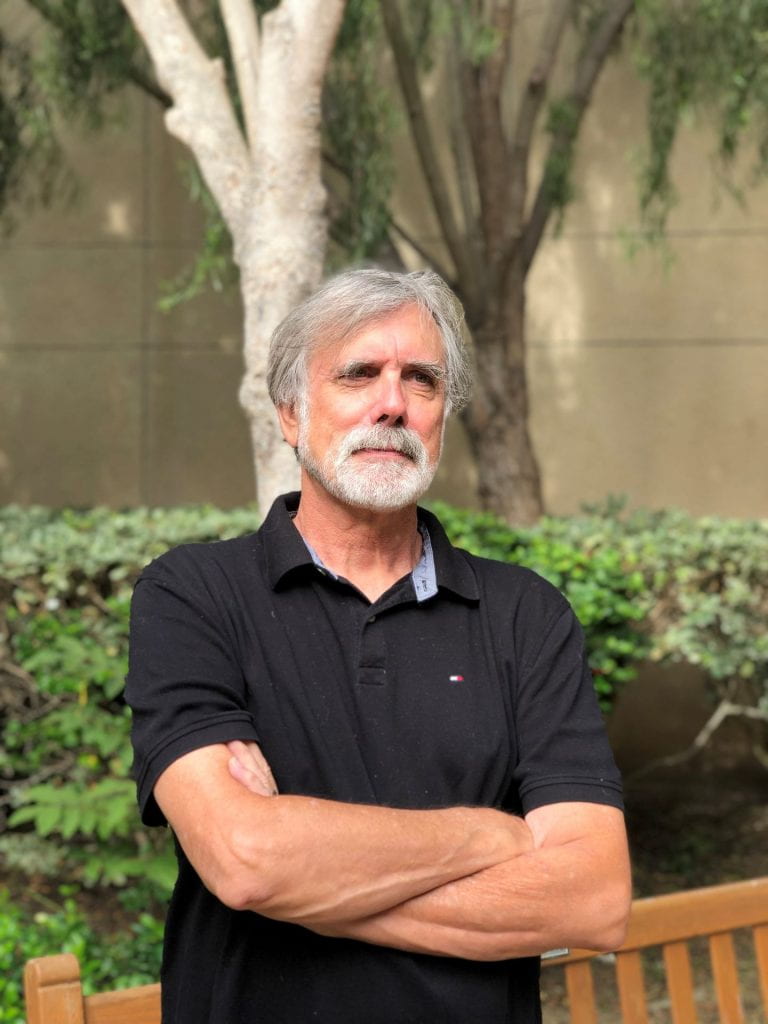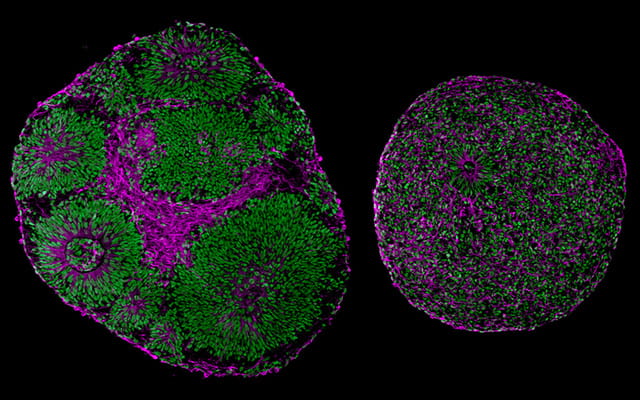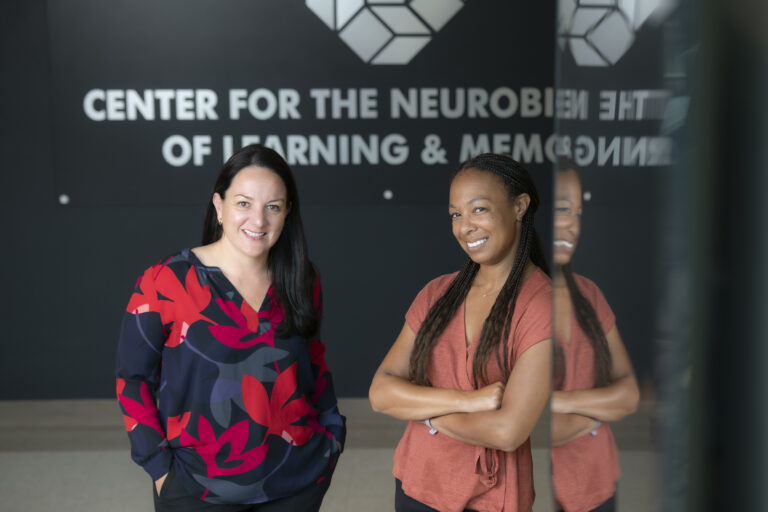Previously thought to be mere connective tissue and support for neurons, astrocytes are now understood to have many functions in the nervous system that are linked with seizures and epilepsy.
Tag: Neurobiology
Are brain delays a computational disadvantage?
Biological components are less reliable than electrical ones, and rather than instantaneously receive the incoming signals, the signals arrive with a variety of delays.
Impact of pollutants on pollinators, and how neural circuits adapt to temperature changes
The Kavli Foundation and the U.S. National Science Foundation are collaborating to accelerate research in the emerging field of neurobiology in changing ecosystems. Awardees of the first Kavli-NSF grants will study the impact of atmospheric pollutants on the sense of smell in pollinators, and how neural circuits adapt to changes in temperature.
Activity in brain system that controls eye movements highlights importance of spatial thinking
The superior colliculus is a midbrain region that is traditionally thought to help animals orient themselves toward important locations in space, like directing their eyes and head toward a bright flash of light. New research from the University of Chicago shows that this part of the brain also plays a role in complex cognitive tasks like visual categorization and decision making.
David Freedman named Chair of the Department of Neurobiology
Freedman succeeds S. Murray Sherman, who has been chair since 2006.

Steve Maren to lead Beckman Institute for Advanced Science and Technology
Steve Maren, a neuroscientist who studies the neurobiology of emotional learning and memory, will become the next director of the Beckman Institute for Advanced Science and Technology at the University of Illinois Urbana-Champaign.
What Researchers Know about the Genetic Complexity of Schizophrenia, To Date
A new review article written by researchers at the UNC School of Medicine and the Karolinska Institutet, outline the genetic, neurobiological, and environmental foundations that contribute to the development of schizophrenia.
Neuroscientists Discover Brain Circuits Involved in Placebo Effect for Pain Relief
Publishing in Nature, University of North Carolina School of Medicine researchers and colleagues discovered a pain control pathway that links the cingulate cortex in the front of the brain, through the pons region of the brainstem, to cerebellum in the back of the brain.
Study Pinpoints Origins of Creativity in the Brain
The new results could ultimately help lead to interventions that help spark creative thought or aid people who have mental illnesses that disrupt these regions of the brain.
UC Irvine-led study unlocks the secrets of birth defect origins
Irvine, Calif., March 21, 2024 – A new study led by the University of California, Irvine has revealed a potential shift in our basic knowledge of the origins of birth defects, which affect about 3 percent of babies born in the United States each year.
Physicists overturn common assumptions regarding brain activity
For the last 75 years a core hypothesis of neuroscience has been that the basic computational element of the brain is the neuronal soma, where the long and ramified dendritic trees are only cables that enable them to collect incoming signals from its thousands of connecting neurons.
Pursuing Three Gene Therapies for Rare Inherited Disease
Researchers hope at least one will treat progressive blindness caused by Usher syndrome type 1F
Researchers Uncover Signal Needed for Blood-Brain Barrier
What makes the vital layer of protective cells around the brain and spinal cord — the blood-brain barrier — more or less permeable has been one of the more mystifying questions in neuroscience.

Addressing disparities in Alzheimer’s disease research
Age-related cognitive decline and the escalating prevalence of Alzheimer’s disease are pressing social challenges as the population of those 65 and older continues to expand. Age is the primary risk factor, but research has shown that social and structural determinants of health play significant roles in the higher incidence of Alzheimer’s among marginalized communities.
“Second-Guessing” Is a Hard-Wired Behavior, Study Suggests
Have you ever made a decision that, in hindsight, seemed irrational? A new study with mice, which could have implications for people, suggests that some decisions are, to a certain extent, beyond their control. Rather, the mice are hard-wired to make them.
Hairs that help fish feel–and humans hear
Brian McDermott, a Case Western Reserve scientist, is reporting a discovery about unexpected asymmetry on the hair cells of zebrafish that allow them to detect movement with greater sensitivity from the back than the front. “This shows that fish have hair cells that are actually tuned to sense different water directions,” McDermott said. “In humans, our cochleas have hair cells that are similarly tuned to be able to hear different frequencies.” McDermott said the finding also advances our understanding of “the long-sought mechanotransduction (Mec) channel” in living creatures.
Untangling the Mystery of Sleep
Sleep is one of the most essential human activities — so essential, in fact, that if we don’t get enough sleep for even one night, we may struggle to think, react, and otherwise make it through the day. Yet, despite its importance for function and survival, scientists still don’t fully understand how sleep works.

UC Irvine School of Medicine associate professor awarded 19th Japan Academy Medal
Kei Igarashi, associate professor of anatomy & neurobiology at the University of California, Irvine School of Medicine, has been named one of six scholars to win the 19th Japan Academy Medal. Widely considered the academy’s most prestigious award for Japanese researchers under the age of 45 in all fields of science and humanities, it was bestowed on Igarashi in recognition of his discoveries on the neural circuit mechanisms of associative memory and how they are affected by Alzheimer’s disease.

Study links exercise intensity, attentional control in late-adolescent girls
Adolescent girls who engage in more moderate and vigorous physical activity each day have better attentional control, a new study finds. The study focused on girls and boys aged 15-18.
UCI researchers discover crucial role of brain’s striatum cilia in time perception
Irvine, Calif., Nov. 30, 2022 — Researchers at the University of California, Irvine have discovered that removal of cilia from the brain’s striatum region impaired time perception and judgment, revealing possible new therapeutic targets for mental and neurological conditions including schizophrenia, Parkinson’s and Huntington’s diseases, autism spectrum disorder, and Tourette syndrome.
Controversial Alzheimer’s drug approval sparks surprising impact
Irvine, Calif., Nov. 29, 2022 — When the U.S. Food and Drug Administration gave controversial accelerated approval to the first Alzheimer’s drug in nearly 20 years, it had a surprising impact on attitudes about research into the disease. A survey by University of California, Irvine neuroscientists has found news coverage of the FDA’s decision made the public less willing to volunteer for Alzheimer’s pharmaceutical trials.
Eye-opening discovery about adult brain’s ability to recover vision
A discovery about how some visually impaired adults could start to see offers a new vision of the brain’s possibilities. The finding that the adult brain has the potential to partially recover from inherited blindness comes from a collaboration between researchers in the University of California, Irvine School of Biological Sciences and the School of Medicine.
Brain-Like Organoids Grown in a Dish Provide Window into Autism
Whatever you do, don’t call them “mini-brains,” say University of Utah Health scientists. Regardless, the seed-sized organoids—which are grown in the lab from human cells—contained an array of neural and other cell types found in the cerebral cortex, the outermost layer of the brain involved in language, emotion, reasoning, and other high-level mental processes. They are providing insights into the brain and uncovering differences that may contribute to autism in some people.

UCI is key member of multi-institutional, $126 million NIH brain mapping project
Irvine, Calif., Sept. 22, 2022 – The University of California, Irvine will participate in a five-year, multi-institutional, $126 million grant from the National Institutes of Health supporting the BRAIN Initiative Cell Atlas Network. The project aims to describe the cells that make up the human brain in unprecedented molecular detail, classifying them into more precise subtypes and pinpointing their location.
Scientists develop blueprint for turning stem cells into sensory interneurons
Key takeaways:
• Just like the real thing. The stem cell–derived interneurons, which play a role in sensations like touch and pain, are indistinguishable from their real-life counterparts in the body.
• Tomorrow’s therapies. In addition to potential treatments for injury-related sensation loss, the discovery could lead to new methods for screening drugs for chronic pain.
• Moving forward. While stem cells from mice were used in the research, scientists are now working to replicate the findings with human cells.

Solving algorithm ‘amnesia’ reveals clues to how we learn
A discovery about how algorithms can learn and retain information more efficiently offers potential insight into the brain’s ability to absorb new knowledge. The findings by researchers at the University of California, Irvine School of Biological Sciences could aid in combatting cognitive impairments and improving technology.

Gene Therapy Reverses Effects of Autism-Linked Mutation in Brain Organoids
UC San Diego scientists use lab-grown human brain tissue to identify neural abnormalities in Pitt-Hopkins Syndrome and show gene therapy tools can rescue neural structure and function.
Neurobiologists Reveal How Value Decisions are Coded into Our Brains
A new study is showing how value choices are recorded in our brains. Researchers found that persistency allows value signals to be most effectively represented, or “coded,” across different areas of the brain, especially in a critical area within the cerebrum known as the retrosplenial cortex.
Right off the bats
Among the many devastating impacts of Alzheimer’s disease and other types of dementia is the risk that patients will wander and become lost. Indeed, according to the Alzheimer’s Association, six in 10 people with the disease will wander at least once over the course of their illness — and many do so repeatedly.
Exploring the Science of Acupuncture
Researchers have discovered neurons needed for acupuncture‘s anti-inflammatory response

UCI receives grant to support 30 HBCU students in Summer Institute in Neuroscience
Irvine, Calif., July 28, 2021 — The UCI Center for the Neurobiology of Learning and Memory has been awarded a UC-HBCU Initiative Summer Research and Graduate Admissions Pathways Grant from the UC Office of the President to sponsor a partnership with Delaware State University, one of 107 Historically Black Colleges and Universities in the U.
Rare Inherited Variants in Previously Unsuspected Genes May Confer Significant Risk for Autism
Researchers have identified a rare class of genetic differences transmitted from parents without autism to their affected children with autism and determined that they are most prominent in “multiplex” families with more than one family member on the spectrum.

How the Brain Paints the Beauty of a Landscape
How does a view of nature gain its gloss of beauty?
What’s riskier for young soccer players, practice or game time?
On average, impacts are more frequent during drills, more severe during games
Device cracks milk protein
‘Refolding’ molecules to support medical solutions
Better healthcare management can reduce the risk of delirium among older adults
New research outlines how those admitted on Sunday and Tuesday are more likely to develop delirium, a hospital complication
Neuroscientists posit that brain region is a key locus of learning
Small and seemingly specialized, the brain’s locus coeruleus (LC) region has been stereotyped for its outsized export of the arousal-stimulating neuromodulator norepinephrine. In a new paper and with a new grant from the National Institutes of Health, an MIT neuroscience…
‘Feel good’ brain messenger can be willfully controlled, new study reveals
Neuroscientists show that mice can learn to manipulate random dopamine impulses for reward
3D imaging reveals neural ‘vicious cycle’ in fatty liver disease
With the application of a novel three-dimensional imaging technology, researchers at Karolinska Institutet in Sweden have discovered that one portion of the autonomic nervous system in the liver undergoes severe degeneration in non-alcoholic fatty liver disease. The study, which is…
Spontaneous retinal waves simulate optical flow before neonatal mice can see
Like dreaming of walking through a world they’ve not yet experienced, the retinas of neonatal mice practice for what mature eyes must later process by generating spontaneous patterns of activity that mimic the perception of directional movement through space, according…
Investigational magnetic device shrinks glioblastoma in first-in-world human test
Houston Methodist Neurological Institute researchers from the department of neurosurgery shrunk a deadly glioblastoma tumor by more than a third using a helmet generating a noninvasive oscillating magnetic field that the patient wore on his head while administering the therapy…
Parkinson’s disease: How lysosomes become a hub for the propagation of the pathology
Over the last few decades, neurodegenerative diseases became one of the top 10 global causes of death. Researchers worldwide are making a strong effort to understand neurodegenerative diseases pathogenesis, which is essential to develop efficient treatments against these incurable diseases.…
Neurotransmitter levels predict math ability
Glutamate and GABA in the brain have reverse relationships with math ability, which switch during development
Scientists reverse age-related memory loss in mice
Scientists at Cambridge and Leeds have successfully reversed age-related memory loss in mice and say their discovery could lead to the development of treatments to prevent memory loss in people as they age. In a study published today in Molecular…
Take two: Integrating neuronal perspectives for richer results
Every brain function, from standing up to deciding what to have for dinner, involves neurons interacting. Studies focused on neuronal interactions extend across domains in neuroscience, primarily using the approaches of spike count correlation or dimensionality reduction. Pioneering research from…
Evidence of sustained benefits of pimavanserin for dementia-related psychosis
Evidence of the sustained benefits of an investigational antipsychotic treatment for people with dementia-related psychosis has been published. Up to half of the 45 million people worldwide who are living with Alzheimer’s disease will experience psychotic episodes, a figure that…
This is how the visual system shows us a more persistent world
An international collaboration elucidates the mechanisms that facilitate accurate identification of moving images. The findings have been published in Nature Communications
Digital health technologies hold key to new Parkinson’s treatments
Global stakeholders come together to collaborate with urgency to address unmet needs for Parkinson’s therapies
Brain ‘noise’ keeps nerve connections young
Neurons communicate through rapid electrical signals that regulate the release of neurotransmitters, the brain’s chemical messengers. Once transmitted across a neuron, electrical signals cause the juncture with another neuron, known as a synapse, to release droplets filled with neurotransmitters that…
Study refutes suspicion that dengue increases risk of microcephaly associated with zika
Researchers compared data for pregnant women in two cities who were infected by zika virus in 2015-16. Factors that influenced the risk of fetal malformation were the high zika attack rate in the area and being infected in the first trimester of pregnan